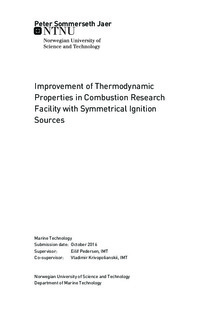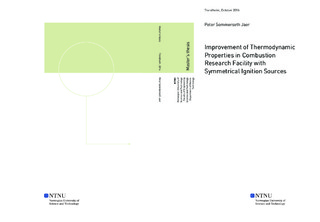| dc.contributor.advisor | Pedersen, Eilif | |
| dc.contributor.advisor | Krivopolianskii, Vladimir | |
| dc.contributor.author | Jaer, Peter Sommerseth | |
| dc.date.accessioned | 2017-03-10T14:46:33Z | |
| dc.date.available | 2017-03-10T14:46:33Z | |
| dc.date.created | 2016-10-10 | |
| dc.date.issued | 2016 | |
| dc.identifier | ntnudaim:16032 | |
| dc.identifier.uri | http://hdl.handle.net/11250/2433682 | |
| dc.description.abstract | The Constant Volume Combustion Chamber (CVCC) at the Combustion Laboratory at the Institute of Marine Technology has shown:
(I) Temperature related issues that reduce reproducibility within test series.
(II) The environment the vessel can simulate is not satisfactory in terms of density.
Previous results and observation with the use of a high-speed camera indicates that the CVCC has an inhomogeneous temperature field. This is due to unsymmetrical heat loss to the wall after pre-combustion, which is used to chemically heat the CVCC to reach the engine-like conditions. The CVCC can run up to a maximum of 100 [bar], which directly affects how much of the gas used for pre-combustion can be injected. The amount of the gas mixture that the old ignition system was capable of igniting cannot be increased substantially without reaching the pressure limit.
These issues were investigated in this present work by installing two types of ignition systems that both aimed to initiate a more symmetrical pre-combustion and to ignite leaner gas mixtures for the pre-combustion. The conventional inductive ignition system from Motortech has a dual spark configuration and an alternative ignition system using Corona Discharge made by Øystein Smith and fellow students at the Omega Workshop at the Norwegian University of Technology and Science (NTNU).
The experiment we conducted on the conventional ignition system indicated a higher maximum pressure level and a faster pre-combustion with a dual spark plug configuration compared to a single spark plug configuration, which could reduce the temperature gradient, but further experimentation is necessary to conclude on this issue. The system indicated an improved capability to ignite lean mixtures, during experiments where the volume fraction of Carbon Monoxide (CO) was reduced when the GMB was further pressurized with Nitrogen gas (N2).
The corona discharge ignition system has promising properties as a symmetrical ignition source to address both issues presented. The challenge is to introduce the voltage into the CVCC without reaching the dielectric strength of the insulating material surrounding the conducting electrode. This would generate an arc between the electrode and the grounded CVCC. The initial experiments we conducted resulted in spark discharge and not corona discharge with all developed electrodes. Further development on the electrodes and a more controllable signal to drive the corona driver is necessary to get this ignition system working properly. | |
| dc.language | eng | |
| dc.publisher | NTNU | |
| dc.subject | Marin teknikk, Marint maskineri | |
| dc.title | Improvement of Thermodynamic Properties in Combustion Research Facility with Symmetrical Ignition Sources | |
| dc.type | Master thesis | |

